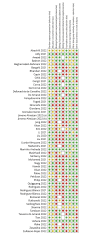Rehabilitation and COVID-19: systematic review by Cochrane Rehabilitation
- PMID: 38214047
- PMCID: PMC10792873
- DOI: 10.23736/S1973-9087.23.08331-4
Rehabilitation and COVID-19: systematic review by Cochrane Rehabilitation
Abstract
Introduction: Until the last update in February 2022, the Cochrane Rehabilitation COVID-19 Evidence-based Response (REH-COVER) action identified an increasing volume of evidence for the rehabilitation management of COVID-19. Therefore, our aim was to identify the best available evidence on the effectiveness of interventions for rehabilitation for COVID-19-related limitations of functioning of rehabilitation interest in adults with COVID-19 or post COVID-19 condition (PCC).
Evidence acquisition: We ran the searches on February 17th, 2023, in the following databases: PubMed, EMBASE, CENTRAL, CINHAL, and the Cochrane COVID-19 Study Register, applying a publication date restriction to retrieve only papers published in 2022. To retrieve papers published before 2022, we screened the reference lists of previous publications included in the REH-COVER action, covering papers from early 2020 to the end of 2022. This current review includes only randomised controlled trials and concludes the rapid living systematic reviews of the Cochrane Rehabilitation REH-COVER action. The risk of bias and certainty of evidence were evaluated in all studies using the Cochrane Risk of Bias tool and GRADE, respectively. We conducted a narrative synthesis of the evidence. PROSPERO registration number: CRD42022374244.
Evidence synthesis: After duplicate removal, we identified 18,950 individual records and 53 RCTs met the inclusion criteria. Our findings suggest that the effect of breathing and strengthening exercise programs on dyspnea and physical exercise capacity compared to no treatment in non-severe COVID-19 patients is uncertain. Multicomponent telerehabilitation may slightly increase physical exercise capacity compared to educational intervention in adults with PCC. There is, however, uncertainty about its effect on lung function and physical exercise capacity when compared to no treatment. Finally, the effect of inspiratory muscle training on maximal inspiratory pressure compared to no treatment in adults with PCC is uncertain.
Conclusions: Interventions that are part of comprehensive pulmonary rehabilitation approaches may benefit dyspnea and exercise tolerance in adults with COVID-19 and PCC. The available evidence has several methodological limitations that limit the certainty of evidence and the clinical relevance of findings. Therefore, we cannot provide robust suggestions for practice. While high-quality RCTs are being conducted, clinicians should consider using high-quality evidence from other pulmonary conditions to rehabilitate patients with COVID-19 or PCC using context-specific interventions.
Conflict of interest statement
Figures
















References
-
- World Health Organization. COVID-19 Epidemiological Update; 2023 [Internet]. Available from: https://www.who.int/publications/m/item/covid-19-epidemiological-update-... [cited 2023, Nov 21].
-
- Bechman K, Yates M, Mann K, Nagra D, Smith LJ, Rutherford AI, et al. Inpatient COVID-19 mortality has reduced over time: results from an observational cohort. PLoS One 2022;17:e0261142. https://www.ncbi.nlm.nih.gov/entrez/query.fcgi?cmd=Retrieve&db=PubMed&l... 10.1371/journal.pone.0261142 - DOI - PMC - PubMed
-
- Davis HE, McCorkell L, Vogel JM, Topol EJ. Long COVID: major findings, mechanisms and recommendations. Nat Rev Microbiol 2023;21:133–46. https://www.ncbi.nlm.nih.gov/entrez/query.fcgi?cmd=Retrieve&db=PubMed&l... 10.1038/s41579-022-00846-2 - DOI - PMC - PubMed
-
- ReliefWeb. A clinical case definition of post COVID-19 condition by a Delphi consensus; 2021 [Internet]. Available from: https://reliefweb.int/report/world/clinical-case-definition-post-covid-1... [cited 2023, Oct 5].
-
- Chen C, Haupert SR, Zimmermann L, Shi X, Fritsche LG, Mukherjee B. Global Prevalence of Post-Coronavirus Disease 2019 (COVID-19) Condition or Long COVID: A Meta-Analysis and Systematic Review. J Infect Dis 2022;226:1593–607. https://www.ncbi.nlm.nih.gov/entrez/query.fcgi?cmd=Retrieve&db=PubMed&l... 10.1093/infdis/jiac136 - DOI - PMC - PubMed
Publication types
MeSH terms
LinkOut - more resources
Full Text Sources
Medical
Miscellaneous

